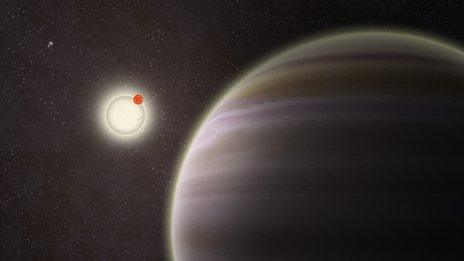Oddballs: The strange worlds beyond our Solar System
- Published
Over the last two decades, astronomers have catalogued around 850 planets outside our Solar System. And the search for worlds orbiting other stars is turning up some weird and wonderful characters.
From a scorched gas giant that's darker than coal, to a planet packed with diamond, here are some of the oddballs-in-chief.
Quadruple sunset

In a memorable scene from the film Star Wars, Luke Skywalker looks out over the horizon while two suns set in the sky of his home planet Tatooine. Astronomers have already discovered several "Tatooine" systems, where planets orbit double stars.
But this year, a team comprising volunteers and professional astronomers reported finding a planet illuminated by four stars, external - the first known of its type.
The distant world orbits one pair of stars and a second stellar pair revolve around them. The planet is being tugged on by the gravitational forces from four different stars yet, despite this complicated environment, PH1 is able to maintain a stable orbit.
The discovery was made by volunteers using the Planethunters.org, external website along with a team from UK and US institutes. Named PH1 after the website, it is located in the constellation Cygnus.
At the time of the discovery, Dr Chris Lintott from Oxford University, told BBC News this was "absolutely not what we would have expected".
He thinks that planets can form in the inner parts of the torus of dense gas that gives rise to planetary systems and then cling to stable orbits close to their parent stars.
Pitch black
In 2011, a group of American astronomers announced that a Jupiter-sized exoplanet known as TrES-2b was the darkest known world, reflecting just 1% of the sunlight falling on it. TrES-2b is darker than black acrylic paint and blacker than any planet or moon in our Solar System.
The distance TrES-2b orbits from its parent star certainly has something to do with this. In our Solar System, Jupiter is shrouded in bright ammonia clouds that reflect more than a third of the sunlight that reaches it.
But TrES-2b orbits its star at a distance of just three million miles. The intense energy from the sun heats the planet to more than 1,000C, which is much too hot for ammonia clouds to form. Its atmosphere also contains chemicals which absorb rather than reflect light. But these factors can't fully explain the planet's extreme lightlessness.
Nevertheless, David Spiegel of Princeton University, who co-authored the study on TrES-2b, says the crepuscular world is so hot that "it emits a faint red glow, much like a burning ember or the coils on an electric stove."
Diamonds are forever
A nearby planet in the constellation of Cancer may have a rather peculiar composition. This body, known as 55 Cancri e, "is likely covered in graphite and diamond rather than water and granite," according to astronomer Nikku Madhusudhan from Yale University.
Belonging to a class of worlds known as diamond planets, 55 Cancri e is thought to be rich in the element carbon, which can exist in a variety of structural forms such as graphite (the material used as pencil lead), graphene, or diamond. Carbon-rich worlds contrast sharply with the Earth, whose interior is relatively poor in that element but rich in oxygen.
This year, Dr Madhusudhan and colleagues published the first measurements of the exoplanet's radius. These new data, combined with the most recent estimates of its mass, allowed the researchers to infer its chemical composition. To do this, they used computer models of the planet's interior and computed the possible combinations of elements and compounds that could yield the observed characteristics.
Their results suggest 55 Cancri e is largely composed of carbon (in the form of graphite and diamond), iron, silicon carbide, and, potentially, silicates. They estimate that at least a third of the planet's mass is diamond - the equivalent of three times Earth's mass.
Ten million years to live

Wasp 12-b is being cooked and contorted into an oval shape by its parent star
Located some 600 light-years away in the constellation Auriga, Wasp-12b is slowly being eaten by its Sun-like star. The giant planet is orbiting so close to its parent star that it is being superheated to a scorching temperature of 1,500C and distorted into a rugby-ball shape by its sun's gravity.
The planet's atmosphere has ballooned to nearly three times the radius of Jupiter and material is spilling on to the Sun-like star. "We see a huge cloud of material around the planet, which is escaping and will be captured by the star," said astronomer Carole Haswell of The Open University.
Haswell and her colleagues used the Hubble Space Telescope to confirm earlier predictions about the planet, publishing their findings in the journal Astrophysical Journal Letters in 2010. They estimate that the planet may have just 10 million years left before it is completely obliterated.
Astronomers have found several other examples of worlds in the process of being devoured by their stars, or being heated up so much that their atmosphere escapes into space, forming a comet-like tail.
- Published28 July 2012